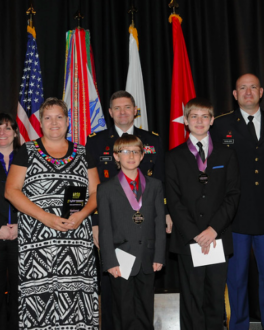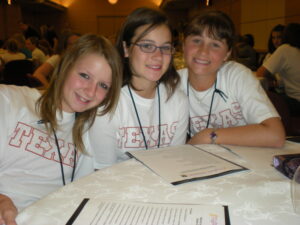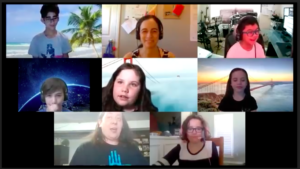February 22, 2021

Heading into our 19th annual eCYBERMISSION competition year, we are reflecting on all the people we have had the pleasure of working with over the years. From teachers to students to school officials, each person holds a special place in our hearts over here at Mission Control. Over the years we have had many repeat competitors, folks who just love the program as much as they love STEM. This year, as we target new people across the country, we are looking to a very experienced Team Advisor to share her perspective from a competitors side, and why she thinks this program is an invaluable resource for teachers.
Laura Wilbanks has taught K-12 science in Whiteface, TX for 28 years, as well as in Dora, NM for 2 years, as the Science Instructional Coach for Southcrest Christian School in Lubbock, TX. She has been a teacher for over 32 years and considers her greatest impact “empowering students to make a difference and change the world for better by realizing you’re NEVER too young to make an impact on others.” We sat down with Laura to talk to her about experiences as a teacher as well as an eCYBERMISSION participant.
What has been the greatest impact your students have made on you?
Laura Wilbanks: Students have taught me to dream bigger, to follow wild & crazy ideas, and to be fearless in reaching out to others. They inspire me by their creativity and heart for others.
Why do you feel STEM is so important?
LW: STEM is the field that encompasses all others and brings problem-solving and critical-thinking to a level where it makes a difference in an authentic way. Students who learn to think creatively and USE stem to solve their own real-life issues can go on to conquer anything. It builds confident young people full of passion and determination.
How did you first hear about eCM?
LW: In 2002, I received a card in the mail at school advertising eCM for 8th and 9th graders, then adding 6th and 7th the next year. It looked like another alternative to traditional science fair but much more. I held onto that card over the summer and the next fall, offered my students the opportunity to choose between a science fair project or an eCM project. It was the most important piece of mail I ever received during my career! I was particularly looking for a challenge for my students in the gifted program. From that year forward, my students entered eCM and tackled tough problems in our community. eCM changed my life and the lives of my students – most of whom are Title I, at-risk kids.
What made you decide to participate in eCM?
LW: eCM stood out as a way for students to do a project that made a real difference – it combined community service with STEM with PBL and that’s what sold it for me. I also loved that it was online, gave many choices of categories for students to use, involved engineering or scientific processes, was judged by multiple judges, and recognized aspects of projects in addition to the STEM – such as team collaboration and creativity, and benefit to the community. Today, I really like that eCM gives the judges feedback and score range which I use to grade their work.
In participating for so many years, what’s the most important thing you’ve learned along the way in participating in eCM?
LW: The most important thing I’ve learned through my participation in eCM is that taking kids through the process is what changes lives – not winning. It is the journey from problem to research to brainstorms to experiments/inventions to testing & analysis to evaluation and to putting the idea into the community as a real solution that is critical. It changes the students – I can’t stress enough how much they learn along this way and how many standards are mastered as well in the classroom. The community partners that are established and university labs where the students are invited to work create powerful networks that link schools with businesses and colleges in the community.
 What is the best piece of advice you could give to another Team Advisor?
What is the best piece of advice you could give to another Team Advisor?
LW: Let your students choose the community problem!! Provide resources to them so they can learn about the various issues in their local/state/global community but let THEM choose in which area to focus. It is the only way I’ve found for the students to have ownership of their project and remained engaged from August to February or longer. One of the key issues with new TAs is that the kids burn out – they’re tired of the project by November – but it is because it was never their idea to begin with. My best piece of advice is make this student-centered around their passions, not your own.
What would you say to someone who is considering participating in eCM?
LW: If you’re considering participating in eCM as a student, I would say to find a TA who will be very involved and has TIME to be involved along your journey, and then GO FOR IT! Do not be afraid to reach out to CyberGuides and Mission Control for advice and help because they’re there to make you successful! They want you to have a life-changing experience and they will support you.
If you’re a teacher or adult leader considering eCM, PLEASE give it a try! You will not regret it! You will be amazed at what your kids can accomplish and there is such a strong support system that you don’t need to feel alone. Besides the help from eCM staff, cyber guides, and online resources, there are REAL TAs to serve as your mentors. They will email, call you, Zoom, do anything you need to help you be successful.
What do you tell your students to help them succeed on their eCM journey?
LW: Oftentimes, my students want to participate in eCM because of the awesome prizes – and they ARE awesome! To help them succeed at the highest level, which to us means going for a win at the state or regional level, I tell them from the beginning to form a team with diverse talents and skills. Include people who are both introverts and extroverts. Include students strong in STEM and students strong in language arts and speaking. Then I tell them to choose a project they’re ALL passionate about. You’re only as strong as your weakest link so be sure to select a community issue that appeals to everyone. I tell my students to choose an issue that doesn’t just affect THEM but also affects other people in other towns, on other continents and they’ll have the potential to make an extraordinary difference. The most important thing I tell my students is to focus on being selfless and helping others – do not focus on “winning” because there are many outstanding students and projects out there as well and we are proud of ALL students for taking this journey!
What have been some of your favorite projects you’ve done?
LW: One of my favorite projects focused on increasing amphibian populations in wetlands. Students developed a “glue” to attach a tiny camera to the back of toads and then track them after a rain – it was such fun!
One project resulted in students accidentally discovering that green tea blocked dangerous UV rays and could be used in a natural sunscreen – an aha moment 12 years ago that won nationals! Oh, if we’d only sought a patent!
I’ve had students come up with some of the most clever ideas over the years that became my favorites! An antibacterial bandage that mimics shark skin texture; designs for nesting boxes of native bees to improve pollination; and pairing WW2 veterans and the Greatest Generation with elementary students to teach about the incredible advances in technology following the war – a project that closed a generation gap in our town.
Was there any one eCM experience that sticks out to? If so, tell us about it.
LW: My Sew-n-Sew team involved students from different schools who formed eCM’s first virtual team and helped children with cancer in each of the hometowns. The kids studied fibers and designed pillowcases which were comfortable during chemotherapy and also antibacterial – benefiting hundreds of children. Five years after that project, the front-page article in a local newspaper told the story of a mother and her 7-year-old daughter fighting cancer. Clutched in her arms was the pillow given to her as a toddler by my students. Although we had moved on, this family was still in the fight of their lives. I use that story when introducing eCM to my incoming 6th graders. My classes are silent as they realize what is truly important about eCM and the real reason we participate each year – making a difference.
If you could change anything about the program, what would it be?
LW: First, I would offer it for 10-12 because the other AEOP programs require students to be from certain geographic areas to participate and that leaves out all your rural schools.
Secondly, in my opinion, and I’d be willing to volunteer and find a way to do this, you need to form a cohort of judges to look at your top 5 winners in each grade level per state and be sure that team #3 isn’t better than team #1. You have great virtual judges but some are strict and some are easy – and a team with a score of 495 from a strict judge trumps a score of 500 from an easy judge – and that could be fixed if you had a team of judges glance over them looking for very glaring and obvious differences. If it’s about the same, leave it be. But if a team as honorable mention is head and shoulders above the first place team, that deserves a closer look in light of students putting in one year’s work.
How was your experience at our virtual NJ&EE versus in-person other years?
LW: I am so appreciative that eCM held a virtual NJ&EE this year when it would’ve been easier for you to just cancel in light of the circumstances. I do not want to say anything that would make you think I do not know how much hard work and effort went in to the virtual event. I’m just going to say that there is no comparison between a virtual event and the in-person event. Part of that is because of the phenomenal job you do in DC for the students and staff. It’s truly the BEST national event for middle school kids. The networking with other advisors for the adults, and the bonds formed between middle schoolers of like-mind from around the world cannot be replicated in Zoom, no matter how much work goes into it. I don’t want to hurt anyone’s feelings, but I will say that when I asked my own 2 teams (one of which had been to an in-person NJEE) their opinions and what they liked BEST, all children said their favorite part of virtual NJ&EE was when they got to Zoom and play games and practice their presentations with the teams from Illinois, New Mexico, and Utah. These events were not part of NJEE, but times when the advisors from these teams got our kids together so they would actually be able to meet other amazing students and advisors who encouraged them, asked them questions in preparation for judges, learned their hobbies, played with them online, etc. Without this interaction for my students, they would not have been very engaged. Today, two of these teams actually got together online to play Pictionary and catch up. NJ&EE is not the same virtually as in-person and I’m grateful that MAYBE you’re trying to find a way for these kids to attend the event in 2021 because they worked an entire year for an opportunity that did not happen for them – they really missed out. I’m proud of their good attitudes throughout the event in light of great disappointment due to COVID. BUT THANK YOU EVER SO MUCH FOR ALL YOU DID!!!
In COVID-19 uncertainties, has the program been a useful tool to help you and other teachers with virtual learning curriculums?
LW: The program year had ended (Feb 28) before the COVID scare began this year (mid-March), but next year, I do think this is a very useful tool for virtual learning. Students can do so much online in contacting experts in the fields, analyzing data, and reaching out to others using social media platforms. eCM is a perfect opportunity for students to feel connected and make a difference, despite the uncertainties of COVID.
Will you be participating next year?
LW: I will always participate in eCM. J I’m looking to move from my role as TA for 17 years to a virtual judge this year. I want the teachers at my school to step up and take the lead in eCM so that this competition is sustainable in our district and has other adults who buy in to the program. I will continue to tell all schools I meet about eCM and how it revolutionizes STEM teaching in the classroom.
Are there any other things you’d like to share about your eCM experience?
LW: I’ve taught for 32 years and participated in eCM for 17 years and been a TA to probably 300 teams over those years. I’ve had 24 teams make it to NJ&EE and my participation in eCM is truly the highlight of my career. The eCM experience has changed my classroom into a student-centered, project-based environment where student accomplishments are far beyond what’s expected for their ages. They just come in and get to work – and do the work of citizen scientists at such a level they astound me. I’ve been inspired every year by them and by the students around the country doing such great work. Our future is in good hands!
There is still a chance for YOU to get involved with eCYBRMISSION as a volunteer. Please visit the website at www.ecybermission.com or just call Mission Control at 1-866-GO-CYBER (462-9237).
This blog was originally published on the eCYBERMISSION website.
Find a Volunteering Opportunity
Visit our Program Volunteers page for a tool to find the best opportunity for you.
eCYBERMISSION Mini-Grant
The eCYBERMISSION Mini-Grant is intended to support teachers/program leaders as they implement eCYBERMISSION with their teams. Educators (formal and informal) of students in grades 6-9 are encouraged to apply.
